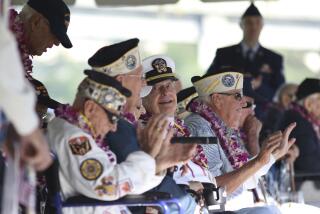Atom bombs’ fallout still felt by Japanese survivors in Southland
More than anything else, the colors remain vividly etched in Kaz Suyeishi’s mind when she recalls that fateful August day more than six decades ago as the world’s first atomic bomb exploded over her family’s hometown of Hiroshima.
The beautiful blue of the sky. A tiny white speck falling from an American B-29 bomber. A brilliant flash of orange and yellow. Then a cloud of gray that suddenly enveloped her. The red of blood streaming from victims and sudden fires everywhere. Finally, black — charred bodies, trees, wooden buildings.
“In an instant, what began as a heavenly day turned to hell,” Suyeishi, now an 80-year-old Torrance resident, said Monday.
For the last three days, Suyeishi and about 150 other atomic-bomb survivors in the Los Angeles area have gathered in Torrance for biennial exams by a team of doctors from Hiroshima. The visit marks the 30-year anniversary of the Japanese mission to monitor the health of North America’s estimated 1,000 survivors, whose average age is 75.
Shizuteru Usui, the mission’s general team leader and president of the Hiroshima Prefectural Medical Assn., said survivors in North America and Japan suffer higher incidences of cancer, thyroid disease and other medical problems than the unexposed population.
The Hiroshima-based Radiation Effects Research Foundation has found, for instance, that cancer-related mortality rates are 50% higher among survivors than in the unexposed population, said Nobuo Nishi, the assistant chief of the foundation’s epidemiology department.
The atomic bomb exploded at 8:15 a.m. on Aug. 6, 1945, releasing massive radiation, scorching heat and a blast that knocked down homes and buildings, burying people under glass and debris. Although casualty figures vary, Hiroshima officials have estimated that about 140,000 people had died by December 1945. About 200,000 survivors remain in Japan, Usui said.
“As the atomic bomb survivors age,” Usui said, “we have to put even more effort into supporting them.”
Suyeishi, president of the American Society of Hiroshima-Nagasaki Atomic Bomb Survivors, led the first effort in 1967 to seek medical assistance from Japan. Survivors told Japanese authorities that they needed doctors who were fluent in Japanese and experienced in dealing with radiation disease.
Suyeishi, a Pasadena native who went back with her family to Hiroshima as an infant and returned to California for college, said she encountered well-meaning American doctors who were clueless about radiation disease. Once, when bruises appeared all over her arms, her American doctor told her that she was simply “homesick” and advised her to go back to Japan. But her Hiroshima doctors told her that the skin disease was related to her radiation exposure, she said.
The Japanese government agreed to begin sending medical teams in 1977. But because the doctors were not licensed to practice in the United States, they needed local partners to provide supervision.
That was provided by Japanese doctors who were practicing at the now-defunct City View Hospital, then located in downtown Los Angeles. The Los Angeles County Medical Assn. also assisted, said Fred Y. Sakurai, one of the original City View physicians who now heads Japanese Community Health Inc. in Little Tokyo.
Sakurai’s organization helps coordinate the biennial medical visits, offers free monthly medical counseling sessions for survivors and grants scholarships to Japanese-English bilingual student nurses.
The physician is a Tokyo native but has a personal reason for helping the survivors: His brother was caught in the Hiroshima atomic bomb blast as a member of the Japanese Navy. His brother, who lives in Tokyo, has since suffered bladder, rectal and colon cancers, although there is no family history of the diseases, Sakurai said.
“I can’t take care of my brother, but I can take care of the atomic bomb survivors here,” Sakurai said.
During the three-day visit, the 11-member Japanese medical team worked out of the Little Company of Mary Hospital in Torrance. They measured height, weight and blood pressure; took blood, urine and stool tests, screened for uterine cancer, and gave breast, thyroid and rectal exams.
In a report after the last visit in 2005, the team found that hypertension was the most prevalent problem, diagnosed in more than half of those examined. One in five had a history of malignant tumors; diabetes, hypercholesterolemia and hypothyroidism were other problems.
Suyeishi was one of the luckier ones. Despite months of nausea, weight loss and other effects of radiation sickness directly after the blast, she managed to survive and escape such debilitating diseases as cancer.
So did her family, although her father suffered third-degree burns on most of his body and lived with disfiguring scars the rest of his life. She will never forget the moment she grasped his hand on the day of the blast and his charred skin peeled off “like a boiled tomato,” she said.
But her father never complained, she said, and even tried to make light of his injuries. He would gather children to his home and jokingly offer a geography lesson, using his scars as maps of the world.
Today, Suyeishi said, she tries to follow her parents’ counsel to forgive, forget and never complain.
She avoids antiwar and anti-nuclear rallies and demonstrations, preferring to share her experiences at schools, churches and community centers.
Her message: “Forgive, love and educate people.”
“I don’t talk about who started the war or who dropped the bomb,” Suyeishi said. “That’s not the point. The point is never to let it happen again.”
teresa.watanabe@latimes.com
More to Read
Start your day right
Sign up for Essential California for news, features and recommendations from the L.A. Times and beyond in your inbox six days a week.
You may occasionally receive promotional content from the Los Angeles Times.







